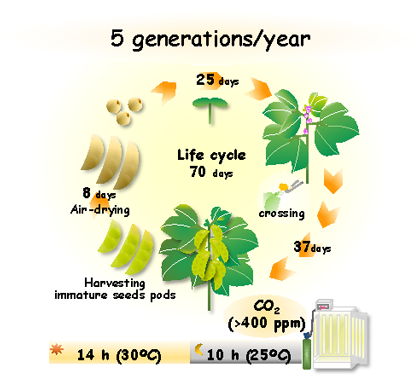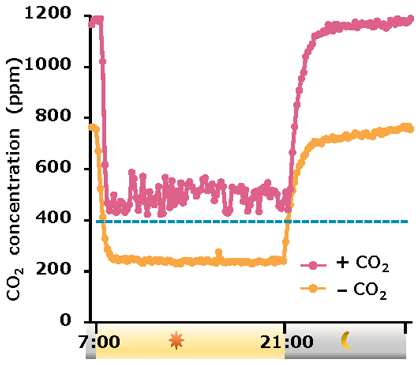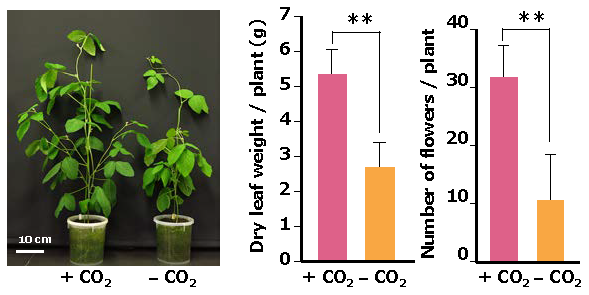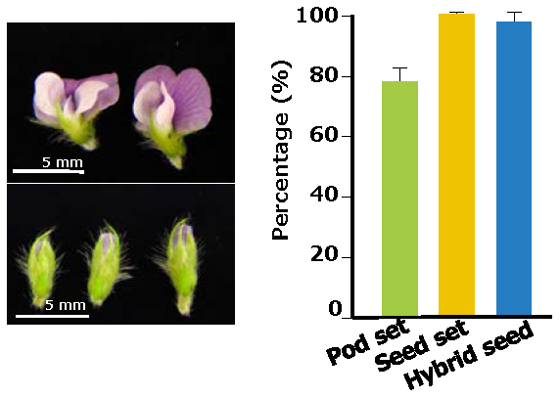Accelerating soybean breeding in a CO2-supplemented growth chamber
Description
Soybean (Glycine max L. Merr.) originated in East Asia, including Japan, and is the most important dicot crop worldwide. Soybean is increasingly used as a model legume due to the availability of genomic resources in this species, and the decreasing cost of sequencing has further encouraged plant researchers to shift their focus from model plants to soybean. Nonetheless, the long generation times of this crop pose a major obstacle to soybean research and breeding. Recently, Watson et al. (2018, Nature Plants) reported a speed breeding method for reducing the generation times of long-day crops such as wheat and barley using a prolonged photoperiod; however, no useful methods for speed breeding short-day soybean plants have currently been published.
Here, we demonstrate a method for accelerating soybean breeding in the compact growth chambers (internal volumes of approximately 0.4 m3) with fluorescent lamps (220 µmol m–2 s–1 at the canopy level) commonly used for laboratory research, which facilitate soybean breeding and research projects. We utilized the 14-h light (30°C)/10-h dark (25°C) cycle, which reduced flowering time, and the immature seeds to reduce reproductive phase. Additionally, supplementation of carbon dioxide (CO2) over 400 ppm promoted soybean growth, yield, and number of healthy flowers, and thus our method also facilitates the highly efficient and controlled crossing of soybean plants. Using this approach, the generation time of the best-characterized elite Japanese soybean cultivar, Enrei, was shortened to just 70 days, thereby allowing up to 5 generations per year with efficient crossing instead of the 1–2 generations currently possible in the field and/or greenhouse.
Thus, CO2 supplementation and appropriate light and temperature conditions combined with immature seeds enable the acceleration of soybean breeding in the compact growth chambers. Given that each soybean cultivar can be cultivated only in limited latitudes, the photoperiod conditions among the parameters in our method needs to be adapted for each cultivar. Alongside other protocols for speed breeding and effective phenotyping, the parameters used in our method could be optimized for a variety of species, cultivars, accessions, and experimental designs to facilitate cutting-edge breeding in a wide range of crops.
Figure, table
-
Fig 1. Schematic representation of our method for accelerating breeding in soybean (cv. Enrei) in a growth chamber supplemented with CO2.
-
Fig 2. The internal CO2 concentrations within growth chambers containing soybean plants are decreased during light periods.
The data were collected every 10 minutes over a single day, 25 days after flower initiation in the soybean plants. -
Fig 3. CO2 supplementation enhances soybean growth and flower number in growth chambers.
Images show 31-day-old soybean plants.
The graphs show the dry leaf weight per plant at 31 days after sowing, and the number of healthy flowers produced during the first 5 days of flowering in growth chambers. (n = 4, Bar = SD. **p < 0.01). -
Fig 4. The soybean flowers grown in the CO2-supplemented growth chamber are useful for effective crossing.
Images show flowers (upper) and flower buds (lower) of soybean plants grown in the CO2-supplemented growth chamber. The graph shows the crossing efficiencies in soybean plants grown in CO2-supplemented growth chambers. (n = 36, Bar = SD.)
- Affiliation
-
Japan International Research Center for Agricultural Sciences Biological Resources and Post-harvest Division
- Research project
- Program name
- Term of research
-
FY2018(FY2016-FY2020)
- Responsible researcher
-
Nagatoshi Yukari ( Biological Resources and Post-harvest Division )
Fujita Yasunari ( Biological Resources and Post-harvest Division )
- ほか
- Publication, etc.
-
https://doi.org/10.1093/pcp/pcy189
Nagatoshi Y and Fujita Y (2019) Plant Cell Physiol, 60:77-84
- Japanese PDF
-
A4382.02 KB
A3374.77 KB
- English PDF
-
A4238.11 KB
A3231.18 KB
- Poster PDF
-
2018_B05_poster.pdf357 KB




